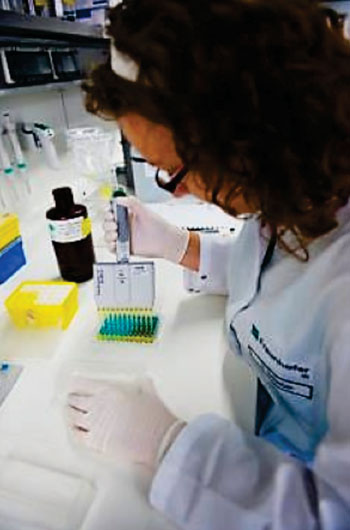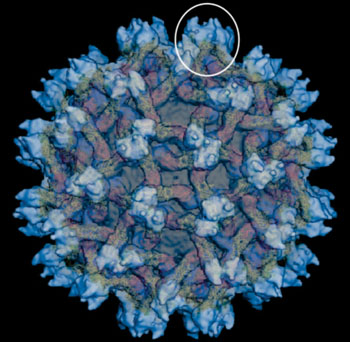Novel Immunoassay Developed to Diagnose Dengue
|
By LabMedica International staff writers Posted on 17 Jan 2016 |

Image: Novel Immunoassay for Dengue virus (Photo courtesy of Fraunhofer IZI).

Image: The immature dengue viral particle. Notable are the 60 protein “spikes” which jut from the surface, making the immature particle far less smooth than the mature form (Photo courtesy of Purdue University).
Until now, it has been difficult to diagnose whether someone is suffering from dengue fever or whether they have contracted another flavivirus, such as yellow fever, West Nile virus, or Tick-borne encephalitis virus (TBEV).
Although there are already tests on the market, but none of them can tell the difference between these individual flaviviruses and if a definitive diagnosis is required, a sample of the patient's blood has to be sent to a high-security laboratory for analysis.
Scientists at the Fraunhofer Institute for Cell Therapy and Immunology (Leipzig, Germany) have developed a definitive antibody test for Dengue virus. Conventional antibody tests are performed by the health professional who draws the patient's blood. If infected with the Dengue virus, the blood will contain specific antibodies produced by the body to attack the intruder. The laboratory staffer then applies the blood to a test platform with dengue antigens that systematically bind with these antibodies. If, after a set reaction time, antibodies are found on the platform, the physician will assume that the patient has been infected with the Dengue virus. The catch is that, although the antigens bind with the antibodies according to the lock and key principle, they almost always do so at the same site as all other flaviviruses. This means that, even when the test is positive, no one can say for sure that it is actually a case of dengue.
The scientists hope that their test will hit the market around one year from now. In a further step, they are working on ways to differentiate between the four strains of the dengue pathogen. This could be an important breakthrough: Anyone who has survived a dengue-related illness has then acquired immunity against that specific pathogen, but when it comes to the other three strains, that person is at even greater risk. This is because the antibodies they produced to combat the first bout of dengue fever actually help the new virus to spread and make it much harder for that person to recover.
Dr. Sebastian Ulbert, Head of the Working Group on Vaccine Technologies, said, “We've succeeded in developing the first ever antibody test for dengue infections that is capable of distinguishing between dengue and other flaviviruses. Since our test is also based on detecting antibodies, it's just as cheap and easy to run as its conventional counterparts. Our test system has the potential to differentiate between the four viral strains.” The new method can easily be integrated into existing test setups and at no extra cost to manufacturers.
Related Links:
Fraunhofer Institute for Cell Therapy and Immunology
Although there are already tests on the market, but none of them can tell the difference between these individual flaviviruses and if a definitive diagnosis is required, a sample of the patient's blood has to be sent to a high-security laboratory for analysis.
Scientists at the Fraunhofer Institute for Cell Therapy and Immunology (Leipzig, Germany) have developed a definitive antibody test for Dengue virus. Conventional antibody tests are performed by the health professional who draws the patient's blood. If infected with the Dengue virus, the blood will contain specific antibodies produced by the body to attack the intruder. The laboratory staffer then applies the blood to a test platform with dengue antigens that systematically bind with these antibodies. If, after a set reaction time, antibodies are found on the platform, the physician will assume that the patient has been infected with the Dengue virus. The catch is that, although the antigens bind with the antibodies according to the lock and key principle, they almost always do so at the same site as all other flaviviruses. This means that, even when the test is positive, no one can say for sure that it is actually a case of dengue.
The scientists hope that their test will hit the market around one year from now. In a further step, they are working on ways to differentiate between the four strains of the dengue pathogen. This could be an important breakthrough: Anyone who has survived a dengue-related illness has then acquired immunity against that specific pathogen, but when it comes to the other three strains, that person is at even greater risk. This is because the antibodies they produced to combat the first bout of dengue fever actually help the new virus to spread and make it much harder for that person to recover.
Dr. Sebastian Ulbert, Head of the Working Group on Vaccine Technologies, said, “We've succeeded in developing the first ever antibody test for dengue infections that is capable of distinguishing between dengue and other flaviviruses. Since our test is also based on detecting antibodies, it's just as cheap and easy to run as its conventional counterparts. Our test system has the potential to differentiate between the four viral strains.” The new method can easily be integrated into existing test setups and at no extra cost to manufacturers.
Related Links:
Fraunhofer Institute for Cell Therapy and Immunology
Latest Microbiology News
- New UTI Diagnosis Method Delivers Antibiotic Resistance Results 24 Hours Earlier
- Breakthroughs in Microbial Analysis to Enhance Disease Prediction
- Blood-Based Diagnostic Method Could Identify Pediatric LRTIs
- Rapid Diagnostic Test Matches Gold Standard for Sepsis Detection
- Rapid POC Tuberculosis Test Provides Results Within 15 Minutes
- Rapid Assay Identifies Bloodstream Infection Pathogens Directly from Patient Samples
- Blood-Based Molecular Signatures to Enable Rapid EPTB Diagnosis
- 15-Minute Blood Test Diagnoses Life-Threatening Infections in Children
- High-Throughput Enteric Panels Detect Multiple GI Bacterial Infections from Single Stool Swab Sample
- Fast Noninvasive Bedside Test Uses Sugar Fingerprint to Detect Fungal Infections
- Rapid Sepsis Diagnostic Device to Enable Personalized Critical Care for ICU Patients
- Microfluidic Platform Assesses Neutrophil Function in Sepsis Patients
- New Diagnostic Method Confirms Sepsis Infections Earlier
- New Markers Could Predict Risk of Severe Chlamydia Infection
- Portable Spectroscopy Rapidly and Noninvasively Detects Bacterial Species in Vaginal Fluid
- CRISPR-Based Saliva Test Detects Tuberculosis Directly from Sputum
Channels
Clinical Chemistry
view channel
Blood Test Could Predict and Identify Early Relapses in Myeloma Patients
Multiple myeloma is an incurable cancer of the bone marrow, and while many patients now live for more than a decade after diagnosis, a significant proportion relapse much earlier with poor outcomes.... Read more
Compact Raman Imaging System Detects Subtle Tumor Signals
Accurate cancer diagnosis often depends on labor-intensive tissue staining and expert pathological review, which can delay results and limit access to rapid screening. These conventional methods also make... Read moreMolecular Diagnostics
view channel
Sepsis Test Demonstrates Strong Performance in Post-Cardiac Surgery Patients
Sepsis is difficult to diagnose accurately in patients recovering from major surgery, as infection-related symptoms often overlap with non-infectious systemic inflammatory responses. This challenge is... Read more
Next-Gen Automated ELISA System Elevates Laboratory Performance
A next-generation automated ELISA system is designed to elevate laboratory performance through advanced workflow automation, enhanced connectivity, and a modernized user experience. DYNEX Technologies... Read more
At-Home Blood Tests Accurately Detect Key Alzheimer's Biomarkers
Diagnosing Alzheimer’s disease typically relies on brain scans or spinal fluid tests, which are invasive, costly, and difficult to access outside specialist clinics. These barriers have limited large-scale... Read more
Blood Test Combined with MRI Brain Scans Reveals Two Distinct Multiple Sclerosis Types
Multiple sclerosis (MS) affects more than 2.8 million people worldwide, yet predicting how the disease will progress in individual patients remains difficult. Current MS classifications are based on clinical... Read moreHematology
view channel
MRD Tests Could Predict Survival in Leukemia Patients
Acute myeloid leukemia is an aggressive blood cancer that disrupts normal blood cell production and often relapses even after intensive treatment. Clinicians currently lack early, reliable markers to predict... Read more
Platelet Activity Blood Test in Middle Age Could Identify Early Alzheimer’s Risk
Early detection of Alzheimer’s disease remains one of the biggest unmet needs in neurology, particularly because the biological changes underlying the disorder begin decades before memory symptoms appear.... Read more
Microvesicles Measurement Could Detect Vascular Injury in Sickle Cell Disease Patients
Assessing disease severity in sickle cell disease (SCD) remains challenging, especially when trying to predict hemolysis, vascular injury, and risk of complications such as vaso-occlusive crises.... Read more
ADLM’s New Coagulation Testing Guidance to Improve Care for Patients on Blood Thinners
Direct oral anticoagulants (DOACs) are one of the most common types of blood thinners. Patients take them to prevent a host of complications that could arise from blood clotting, including stroke, deep... Read moreImmunology
view channel
Ultrasensitive Liquid Biopsy Demonstrates Efficacy in Predicting Immunotherapy Response
Immunotherapy has transformed cancer treatment, but only a small proportion of patients experience lasting benefit, with response rates often remaining between 10% and 20%. Clinicians currently lack reliable... Read more
Blood Test Could Identify Colon Cancer Patients to Benefit from NSAIDs
Colon cancer remains a major cause of cancer-related illness, with many patients facing relapse even after surgery and chemotherapy. Up to 40% of people with stage III disease experience recurrence, highlighting... Read morePathology
view channel
ADLM Updates Expert Guidance on Urine Drug Testing for Patients in Emergency Departments
Urine drug testing plays a critical role in the emergency department, particularly for patients presenting with suspected overdose or altered mental status. Accurate and timely results can directly influence... Read more
New Age-Based Blood Test Thresholds to Catch Ovarian Cancer Earlier
Ovarian cancer affects around one in 50 women during their lifetime, with roughly 7,000 diagnoses each year in the UK. The disease is often detected late because symptoms such as bloating, abdominal pain,... Read moreTechnology
view channel
Pioneering Blood Test Detects Lung Cancer Using Infrared Imaging
Detecting cancer early and tracking how it responds to treatment remains a major challenge, particularly when cancer cells are present in extremely low numbers in the bloodstream. Circulating tumor cells... Read more
AI Predicts Colorectal Cancer Survival Using Clinical and Molecular Features
Colorectal cancer is one of the most common and deadly cancers worldwide, and accurately predicting patient survival remains a major clinical challenge. Traditional prognostic tools often rely on either... Read moreIndustry
view channel
BD and Penn Institute Collaborate to Advance Immunotherapy through Flow Cytometry
BD (Becton, Dickinson and Company, Franklin Lakes, NJ, USA) has entered into a strategic collaboration with the Institute for Immunology and Immune Health (I3H, Philadelphia, PA, USA) at the University... Read more



















